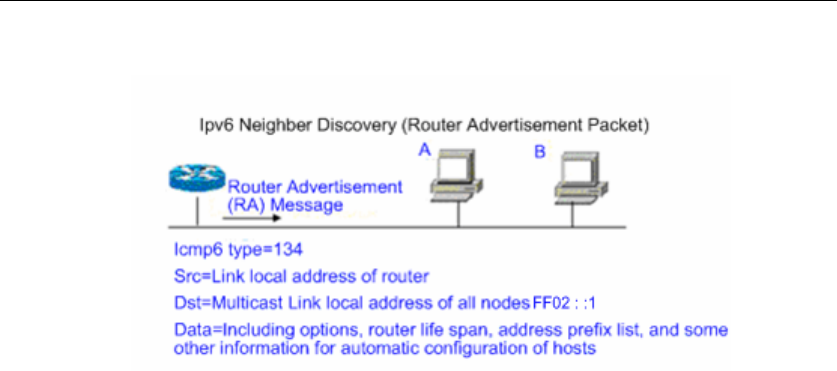
DES-7200 Configuration Guide Chapter 2 IPv6 Configuration
2-13
In general, the Router Advertisement (RA) contains the contents below:
z One or more IPv6 address prefixes used for the on-link confirmation or the
stateless address auto-configuration.
z Effective period of the IPv6 address prefix.
z Usage of the host auto-configuration (Stateful or stateless).
z Information for the default router (namely, determine whether this router is taken
as the default router. If yes, it will announce the time as the default router itself).
z Other information for configuration such as the hop limit, the MTU and the
neighbor solicitation retransmission interval.
The Router Advertisement (RA) is also used to respond to the Router Solicitation (RS)
message sent by the host. The Router Solicitation (RS) message allows the host to
obtain the auto-configuration information immediately without waiting for the router to
send the Router Advertisement (RA). If there is no unicast address when the host is
activated, the Router Solicitation (RS) message sent by the host will use the
unassigned address (0:0:0:0:0:0:0:0) as the source address of the solicitation
message. Otherwise, the existing unicast address is taken as the source address,
while the Router Solicitation (RS) message uses the multicast address (FF02::2) of all
routers for the local link as the destination address. As the response router solicitation
(RS) message, the Router Advertisement (RA) message will use the source address of
the solicitation message as the destination address (if the source address is the
unassigned address, it will use the multicast address FF02::1) of all nodes for the local
link.
The following parameters can be configured in the Router Advertisement (RA)
message:
Ra-interval: Interval of sending the Router Advertisement (RA).
Ra-lifetime: Router lifetime, namely whether the device is acted as the default router of
the local link and the time as this role.


















